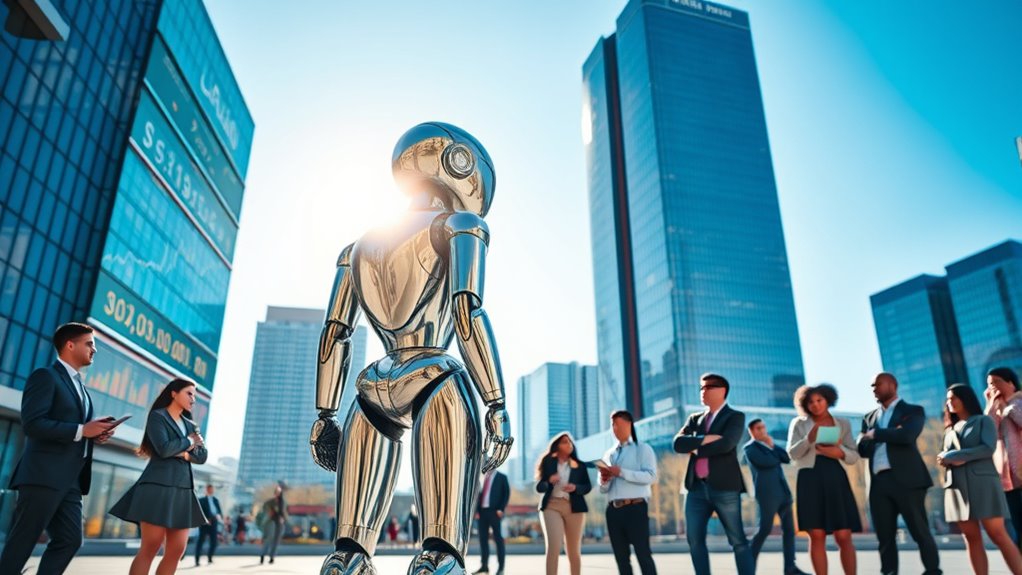Taxing robots could help fund social programs and reduce inequality by redistributing the wealth created through automation. While it offers a promising way to support workers and finance public services, designing practical policies is complex and requires international cooperation. Defining robots clearly and creating fair tax systems are ongoing challenges. If you explore further, you’ll find how global efforts aim to balance economic growth with social fairness in this evolving landscape.
Key Takeaways
- Robot taxes can generate revenue to fund social programs, but their effectiveness depends on proper implementation and enforcement.
- Implementing a robot tax may slow automation, potentially hindering productivity growth necessary for economic development.
- International coordination is crucial to prevent tax avoidance and ensure fair, consistent policies across countries.
- Defining what constitutes a “robot” is complex, posing challenges to establishing a clear and effective tax framework.
- Revenue from robot taxes alone is unlikely to fully fund future societal needs; complementary policies are essential.
The Rationale Behind Robot Taxation

Have you ever wondered why governments weigh taxing robots? The main reason is to redistribute wealth created by automation, helping workers and supporting public services. By taxing robots, governments aim to slow job losses caused by rapid automation, making it more costly for companies to replace human workers. This approach also promotes economic equity by sharing the benefits of increased productivity across society. The revenue from such taxes could fund education, retraining programs, and social welfare, addressing income inequality worsened by automation. Additionally, automation’s economic impact underscores the need for policies like robot taxation to ensure that technological advancements benefit all members of society. Understanding labor market dynamics can help frame effective strategies for managing automation’s effects. A robot tax can also generate substantial revenue that can be reinvested into social programs and infrastructure. Recognizing the importance of public acceptance is crucial for successful implementation of such policies. As AI and automation continue to evolve, considering the divergence between human and artificial intelligence becomes essential for shaping equitable policies.
Lessons From South Korea’S Approach

South Korea’s approach to robot taxation offers valuable lessons by implementing policies that directly influence automation investments. Their 2017 policy reduces tax incentives for companies investing in automation, aiming to balance the benefits of robotics with employment concerns. Instead of taxing robots directly, the government adjusts capital investment deductions, limiting deductions from 3-7% and proposing further reductions. This strategy affects manufacturing sectors heavily reliant on automation, encouraging innovation while mitigating job displacement. With a high robot density of 1,000 robots per 10,000 workers, South Korea faces unique challenges. The policy supports social welfare and maintains tax revenue, demonstrating that targeted tax adjustments can address automation’s economic impact. It highlights the importance of aligning technological progress with workforce development and social stability. Additionally, nightingale studio emphasizes the need for comprehensive strategies that consider both technological advancement and social implications. Furthermore, monitoring the financial impact of such policies ensures they effectively balance economic growth with social equity. Incorporating aura insights can also help policymakers understand the emotional and social effects of automation on the workforce and community well-being. Recent studies on AI security vulnerabilities underscore the importance of developing robust safety measures as automation advances. As automation continues to evolve, considering long-term societal effects becomes essential for sustainable policy development.
Economic and Social Implications of a Robot Tax

Implementing a robot tax can considerably influence both the economy and society by altering how industries adopt automation. You might see slower adoption of robotics, especially in manufacturing, which could hinder economic growth. While automation boosts productivity and creates jobs, a tax could reduce these benefits by discouraging innovation. It may also help offset revenue losses from declining labor taxes and improve global competitiveness, as companies seek regions with favorable policies. Research shows that robot adoption often leads to employment growth, especially among low-skill workers, challenging the job-loss narrative. Socially, a robot tax could address income inequality and job displacement, providing funds for social programs supporting affected workers. Additionally, the way these taxes are structured can influence the overall regulatory environment, affecting both small and large enterprises. However, public perception varies; some see it as necessary, others as counterproductive. Ultimately, a robot tax’s economic and social impacts depend on how it’s designed and implemented, balancing growth, fairness, and innovation.
Challenges in Designing an Effective Robot Tax

Designing an effective robot tax involves steering through numerous legal and ethical challenges that can complicate its implementation. First, you must clearly define what counts as a “robot” for tax purposes, avoiding ambiguity that could lead to loopholes. Establishing a solid legal relationship between humans and AI is essential to determine who’s responsible for taxes. Ethically, you need to set a baseline for AI development, especially as AI consciousness evolves. International standards are *vital* to prevent competitive disadvantages, but creating consensus is difficult. You also face technical hurdles, like monitoring and auditing complex, rapidly advancing technologies. Deciding which types of automation to tax and updating tax codes regularly adds layers of complexity, making it tough to design a fair, effective system. Additionally, you must consider the potential for regulatory gaps that could be exploited by malicious actors, complicating enforcement efforts. Recognizing the different approaches to system design can facilitate better integration and oversight of AI technologies within existing frameworks. Moreover, the rapid advancement of AI capabilities poses ongoing challenges for maintaining effective regulatory measures, especially as new functionalities emerge at a breakneck pace.
Future Perspectives and Global Coordination

The future of robot taxation holds significant potential to influence global economic stability and social equity. International cooperation is key to ensuring fair and effective implementation. Here’s what to contemplate:
- Over 140 countries agreed on global tax reform in 2021, setting a precedent for cooperation. This collective effort demonstrates a recognition of the importance of coordinated policies to manage automation’s impact. Strong international frameworks can facilitate consistent tax policies across borders.
- Establishing international guidelines helps create a level playing field and prevents tax avoidance.
- Without coordination, countries risk economic disadvantages from unilateral actions.
- Global efforts are needed to measure automation’s job impact accurately and develop unified policies. Effective measurement of automation’s impact is essential for crafting responsive and fair tax strategies.
Frequently Asked Questions
How Would a Robot Tax Impact Small and Medium-Sized Enterprises?
A robot tax would increase operational costs for your SME, possibly leading to financial strain and less investment in automation. You might hesitate to adopt new technologies, slowing innovation and productivity. The tax could also influence your hiring decisions, possibly favoring human labor over robots to avoid extra costs. Ultimately, it may challenge your growth, forcing you to weigh automation benefits against higher expenses and regulatory hurdles.
Can Robot Taxes Be Effectively Enforced Across Different Jurisdictions?
You wonder if robot taxes can be enforced across jurisdictions. Enforcing them effectively requires international cooperation, clear legal frameworks, and enforceable agreements, which are challenging due to differing tax laws and technological borders. Without global coordination, countries risk economic disadvantages, and enforcement becomes complex. You need standardized definitions, monitoring systems, and treaty adjustments to guarantee consistent application, making cross-border enforcement difficult but essential for fair and effective taxation.
What Are the Ethical Considerations of Taxing Autonomous AI Systems?
You should consider that AI inherits biases from 80% of training data, raising fairness issues when taxing these systems. Ethically, you must balance transparency, privacy, and accountability, ensuring AI decisions remain explainable and data protected. Taxing AI impacts workers, society, and innovation. You’re tasked with creating fair, ethical policies that promote societal benefits without stifling technological progress, considering global standards for responsible AI taxation.
How Might Robot Taxes Influence Innovation in AI and Automation Industries?
You might worry that taxing robots could slow down innovation in AI and automation industries. When taxes increase development costs, companies may hesitate to invest in new technologies, limiting progress. However, if implemented thoughtfully, such taxes could encourage more strategic automation use, balancing growth with societal benefits. Ultimately, your approach should aim to support innovation while ensuring that automation benefits everyone fairly.
Are There Alternative Policies to Mitigate Job Losses From Automation?
You can explore alternatives to mitigate job losses from automation by investing in reskilling programs that help workers adapt to new technologies. Encouraging education in future-proof skills, supporting small businesses, and promoting entrepreneurship create new opportunities. Strengthening social safety nets, implementing fair regulations, and fostering industry diversification also protect workers and stimulate growth. These policies help balance innovation with job security, ensuring a resilient economy despite automation advances.
Conclusion
Imagine a future where robots shoulder some of our economic burdens, but without careful planning, it’s like building a house on shifting sands. A robot tax might seem like a simple fix, yet it risks stifling innovation or creating loopholes. To truly fund our future, you need global cooperation, clear policies, and a balanced approach—only then can we turn the idea of taxing robots from a mere fantasy into a sustainable reality that benefits everyone.









